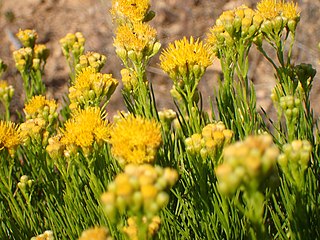
Ericameria arborescens is a North American species of flowering plants in the family Asteraceae known by the common name goldenfleece. It is widespread across much of California and found also in southwestern Oregon.
Hulsea nana is a North American species of flowering plant in the family Asteraceae known by the common name dwarf alpinegold. It is native to the western United States from Washington, Oregon, and far northern California.
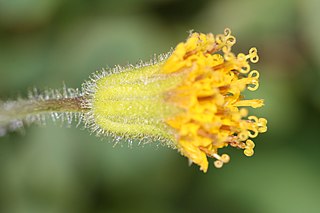
Arnica parryi is a North American species of flowering plant known by the common names Parry's arnica or nodding arnica. It is native to western Canada and the western United States as far south as Inyo County, California and McKinley County, New Mexico. It grows in temperate coniferous forests and alpine meadows in mountainous areas, primarily the Rocky Mountains, Cascades, and Sierra Nevada.
Arnica cernua is a species of arnica known by the common name serpentine arnica. It is native to the Klamath Mountains of northern California and southern Oregon, where it is a member of the serpentine soils flora.

Arnica discoidea is a North American species of arnica in the sunflower family. It is known by the common name rayless arnica because its flower heads have disc florets but none of the showier ray florets. It is native to the woodlands, forests, and chaparral of the western United States (Washington, Oregon, California, and western Nevada.
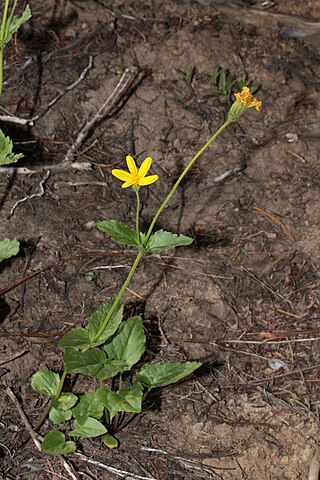
Arnica latifolia is a species of arnica in the sunflower family, known by the common names broadleaf arnica, broad leaved arnica, mountain arnica, and daffodil leopardbane. It is native to western North America from Alaska east to Northwest Territories and south to Mono County, California, and Taos County, New Mexico. It grows in mountain habitat such as forest and meadows.
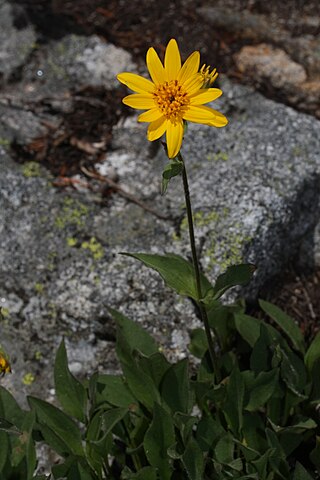
Arnica mollis is a North American species of arnica in the sunflower family, known by the common name soft arnica, or hairy arnica. It is native to Canada and the United States (Alaska and the western mountains as far south as San Bernardino County, California and Rio Arriba County, New Mexico. There are also isolated populations in the White Mountains of Coos County, New Hampshire. The species grows in subalpine mountain habitat such as meadows and streambanks.

Arnica nevadensis is a North American species of arnica in the sunflower family, known by the common names Nevada arnica and Sierra arnica. It is native to the coniferous forests of the western United States, primarily the Cascades and Sierra Nevada.

Arnica sororia is a North American species of flowering plant known by the common name twin arnica. It is native to Western Canada and the Western United States. It grows in grasslands and in conifer forests, as well as the sagebrush steppe.
Arnica spathulata is a rare North American species of flowering plant in the family Asteraceae, known by the common name Klamath arnica. It is native to the Klamath Mountains of northwestern California and southwestern Oregon. It grows in woodland habitat, almost exclusively on serpentine soils.

Arnica venosa is a rare California species of flowering plant in the family Asteraceae known by the common name Shasta County arnica. It should not be confused with the Mt. Shasta arnica, A. viscosa.
Arnica viscosa is an uncommon North American species of flowering plant in the family Asteraceae, known by the common name Mount Shasta arnica.

Artemisia arbuscula is a North American species of sagebrush known by the common names little sagebrush, low sagebrush, or black sagebrush. It is native to the western United States from Washington, Oregon, and California east as far as Colorado and Wyoming. It grows in open, exposed habitat on dry, sterile soils high in rock and clay content.

Crepis occidentalis is a North American species of flowering plant in the family Asteraceae known by the common names western hawksbeard, or largeflower hawksbeard. It is native to western Canada and the western United States.
Crepis pleurocarpa is a North American species of flowering plant in the family Asteraceae known by the common name nakedstem hawksbeard. It is native to the western United States (Washington, Oregon, northern California and western Nevada.
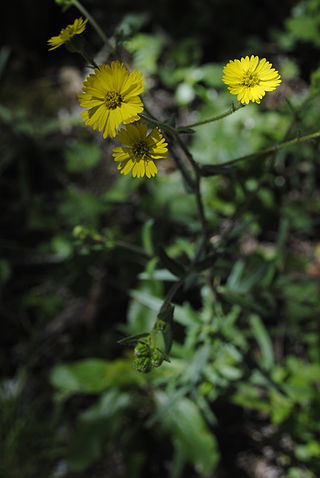
Anisocarpus madioides is a North American species of flowering plant in the family Asteraceae known by the common name woodland madia.

Arnica dealbata is a species of Californian plants in the tarweed tribe within the aster family

Agnorhiza ovata is a species of flowering plant known by the common name southern mule's ears. It is native to the mountains and foothills of southern California and Baja California, occurring the Coast Ranges and Sierra Nevada foothills in Tulare, Kern, Ventura, Los Angeles, Orange, Riverside, and San Diego counties in California, with additional populations in the Peninsular Ranges south of the international border.

Heterotheca shevockii is a rare species of flowering plant in the family Asteraceae known by the common names Kern Canyon false goldenaster and Shevock's goldenaster. It is endemic to California in the United States, where it is known only from Kern County. It grows along a 21-mile stretch of the Kern River.

Arnica lanceolata is a North American species of flowering plant in the family Asteraceae, known by the common name clasping arnica or lanceleaf arnica. It has a disjunct (discontinuous) distribution in western North America and northeastern North America.
















